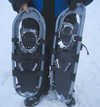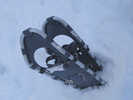

Snowshoes are an ancient way of walking on deep snow. They work on a simple principle of spreading the weight of the wearer by increased surface area meaning that the wearer doesn’t sink so deep into the snow which is called “Flotation”
 Snow shoes as a concept can be seen in nature with the large feet of animals adapted to life in snowy environments. The Snowshoes sometimes known as Webs, have been used by humans living in such environments for thousands of years, possibly as far back as 4,000BC in Western Europe especially in Central Europe and Scandinavia where it is thought the snowshoe evolved into the Nordic Ski, although snowshoes are still used along side Nordic skis in European Arctic communities.
Snow shoes as a concept can be seen in nature with the large feet of animals adapted to life in snowy environments. The Snowshoes sometimes known as Webs, have been used by humans living in such environments for thousands of years, possibly as far back as 4,000BC in Western Europe especially in Central Europe and Scandinavia where it is thought the snowshoe evolved into the Nordic Ski, although snowshoes are still used along side Nordic skis in European Arctic communities.
These early European examples are different in many respects than the traditional webbed snowshoes found among the Native American and Canadian peoples. Each tribe had its own particular design with the Inuit having both triangular and circular style, although in the very far north snowshoes are needed as much as snow doesn’t tend to accumulate on the sea ice. The tribal designs reflect different conditions and requirements such are long and almost ski like for speed, others are shorter for greater manoeuvrability in deep forests. European settlers also adapted to their use especially those involved with the fur trade and trapping.
 Traditionally snowshoes would have a hardwood frame and lacings in a web shape or latticework this means that the shoes don’t gather snow which is vital for them to function correctly. Modern snowshoes are made of light weight metals and strong plastics although some people still prefer wood as it cannot freeze and is much lighter that metal versions, also for hunting wooden snowshoes can be much quieter. Modern Snowshoes evolved again during the 1970s with greater use of light metals and neoprene and nylon lacings with cleats on the bottom, these became known as ‘Western’ Snowshoes. These require little maintenance and sometimes have crampons built in. Other innovations include heel lifters called “ascenders” which help when going up hill, very useful in countries with lots of low hills such as Northern Finland (which the pictures featured here were taken). Different designs exist for different activities such as small fast ones for running, walking and mountaineering versions. The size depends not just on shoe size but also on the weight of the wearer, some have suggested for every ½ kg of weight of wearer the shoes should have 6.5 cm² of surface area per shoe. This is also altered by the nature of the snow to be traveled on with deeper more powdery snow requiring even larger area. Most people prefer to use walking boots when wearing snowshoes as ski boots wont work and gaiters can be useful to stop snow getting into the top of the boots when in deep snow.
Traditionally snowshoes would have a hardwood frame and lacings in a web shape or latticework this means that the shoes don’t gather snow which is vital for them to function correctly. Modern snowshoes are made of light weight metals and strong plastics although some people still prefer wood as it cannot freeze and is much lighter that metal versions, also for hunting wooden snowshoes can be much quieter. Modern Snowshoes evolved again during the 1970s with greater use of light metals and neoprene and nylon lacings with cleats on the bottom, these became known as ‘Western’ Snowshoes. These require little maintenance and sometimes have crampons built in. Other innovations include heel lifters called “ascenders” which help when going up hill, very useful in countries with lots of low hills such as Northern Finland (which the pictures featured here were taken). Different designs exist for different activities such as small fast ones for running, walking and mountaineering versions. The size depends not just on shoe size but also on the weight of the wearer, some have suggested for every ½ kg of weight of wearer the shoes should have 6.5 cm² of surface area per shoe. This is also altered by the nature of the snow to be traveled on with deeper more powdery snow requiring even larger area. Most people prefer to use walking boots when wearing snowshoes as ski boots wont work and gaiters can be useful to stop snow getting into the top of the boots when in deep snow.
Snowshoes require a good depth of snow normally around 20cm deep to work effectively as they can then pack a sufficient layer between their surface and the ground. They are easy to use but practice helps avoid too wide a gait which can be tiring. Turning can be trickier and lifting the foot high out of the snow leaving one leg on the ground can be done sometimes known as kickturn but this requires a good level of fitness and strong hip muscles to do frequently so often a snowshoe wearer will just walk in a wide circle when possible. Note that breaking a trail on fresh snow requires a great deal more effort than following another snowshoer and this should be considered when traveling in a group and considering alternating leads and individual party member's fitness levels.